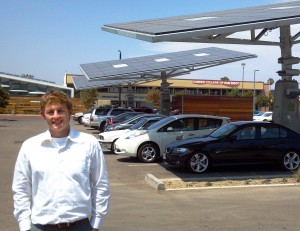August 29, 2012
 With the 2012 presidential election coming up, energy policy ensures itself as a frontline issue that both candidates need to continue to address. The question of where and how we will produce our energy will need to be determined in order to accommodate our future energy demands. Renewable energy has become a hot topic of discussion due to rapidly advancing clean technology as a result of the necessity to find ways to be more sustainable and efficient in our methods of energy use and the ever-present impacts we continue to see in our environment from our current methods. That being said, it is no coincidence that the push for wide acceptance of renewable energy in U.S. (and global) energy policy has influenced the increased interest in renewable energy studies at universities across the nation. Students who are interested in renewable energy studies will be the ones to fill the demand of our growing green job market and help conduct the research to foster the appropriate technology to do so. Students here at ASU are already fulfilling these roles.
With the 2012 presidential election coming up, energy policy ensures itself as a frontline issue that both candidates need to continue to address. The question of where and how we will produce our energy will need to be determined in order to accommodate our future energy demands. Renewable energy has become a hot topic of discussion due to rapidly advancing clean technology as a result of the necessity to find ways to be more sustainable and efficient in our methods of energy use and the ever-present impacts we continue to see in our environment from our current methods. That being said, it is no coincidence that the push for wide acceptance of renewable energy in U.S. (and global) energy policy has influenced the increased interest in renewable energy studies at universities across the nation. Students who are interested in renewable energy studies will be the ones to fill the demand of our growing green job market and help conduct the research to foster the appropriate technology to do so. Students here at ASU are already fulfilling these roles.
I was able to talk to Karen Dada, project manager of ASU’s Solar Energy Engineering and Commercialization Program this week as she gears up for ASU’s fall 2012 semester. The Solar Energy Engineering and Commercialization Program kicked off its first semester in spring 2011 making it the newest addition to ASU’s Professional Science Masters (PSM) degree. The PSM, affirmed by the National Science Foundation, is specifically designed to more efficiently prepare scientists for industry, non-profit, and government sector related careers.
“The PSM degree illustrates a workplace model rather than an academic model,” Dada said. “We’re not just doing what we think needs to be done, we’re doing what the industry directly tells us.”
Students who are completing the Solar Energy Engineering and Commercialization Program work toward an applied project that focuses on high-impact solutions to solar energy and commercialization problems as opposed to a thesis paper that most graduate degrees require. Students work alongside a mentor to develop an individual project that ranges from technical engineering to energy policy. The purpose of working toward an applied project is to prepare these future solar engineers to become the entrepreneurs and innovators of the future.
“Our program focuses on producing solar company entrepreneurs, project managers, and policy makers,” Dada said. “We’re really filling a niche.”
Since its inauguration, the program has already made ASU News headlines for their students’ entrepreneurial endeavors. During his final semester studying in the Solar Energy Engineering and Commercialization Program, student Sage Lopez helped Sunshine Acres Children’s Care Home devise a solar-energy plan that will help control the energy costs of the home as it continues to grow. Lopez assisted in helping Sunshine Acres get closer to its goals of having a “net-zero” energy system within the next 10 years. Because of his applied project, Lopez was able to land himself a position at a San Diego-based company in the solar-energy industry after graduation.
Here is a list of other example applied projects from the Solar Energy Engineering and Commercialization Program.
As technology changes, so does the way we utilize our resources. The energy job market will need creative and educated innovators to use technology to better our future energy demands. If students are interested in pursuing a career in solar, then look no further than pursuing the Solar Engineering and Commercialization Program degree right here at ASU.
“We need to broaden our energy base,” Dada said. “Solar in Arizona is an obvious choice, and it’s a natural fit for ASU to take the lead in helping to create a sustainable energy source for our future.”
Written by Gabrielle Olson, ASU LightWorks
Photo retrieved from ASU News
Additional Information:
http://engineering.asu.edu/semte/Solar.html
http://engineering.asu.edu/semte/docs/solar/PR%20solar%20grant_121111.pdf

